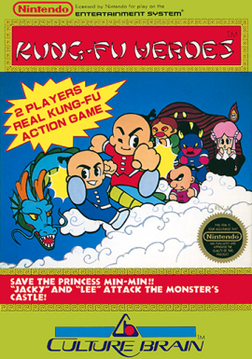Kung Fu Heroes
| Kung-Fu Heroes | |
|---|---|
 Front cover of Kung-Fu Heroes (NES version) | |
| Developer(s) | Nihon Game |
| Publisher(s) |
|
| Series | Super Chinese |
| Platform(s) | Arcade, Nintendo Entertainment System, Wii U Virtual Console |
| Release | Arcade Famicom/NESVirtual Console
|
| Genre(s) | Action Beat 'em up |
| Mode(s) | Up to 2 players, simultaneous |
Chinese Hero (チャイニーズヒーロー, Chainīzu Hīrō), also known in Japan as Super Chinese (スーパーチャイニーズ, Sūpā Chainīzu), is an arcade action game developed by Nihon Game (now Culture Brain) and published by Taiyo System and Taito in October 1984. Chinese Hero is the first game in the Super Chinese series by Culture Brain.[3] It was ported to the Nintendo Entertainment System as Kung Fu Heroes in Japan by the company Nihon Game in 1986 and was released in North America in 1989. The title saw a release on the Nintendo Switch Online service on August 21, 2019, most notably being the first time the North American version has been re-released in a few decades.
Kung-Fu Heroes features an overhead view and up to two players may play simultaneously. It is a direct port of the earlier arcade game Chinese Hero developed by Nihon Game at the time the company was involved in the coin-up industry. Unlike other titles in the series, it does not incorporate any role-playing video game elements in the gameplay.
Plot[]
Monsters have taken Princess Min-Min captive and have stolen the 10 treasures of the nameless land the game takes place in, leaving everything in sorrow. Kung-fu Masters Jacky and Lee return from training and must set out to rescue the princess and find the treasures.

Gameplay[]

The player controls one of the characters, Jacky or Lee, and each level pits the player against countless enemy warriors. The goal is for the player to defeat enough enemies so that the door at the top of the room opens allowing the player to exit the room and proceed to the next. Enemies' attacks and weapons vary throughout the game. There are quite a number of BONUS levels that players can enter.
Reception[]
In Japan, Game Machine listed Chinese Hero on their October 15, 1984 issue as being the most-successful table arcade unit of the month.[4]
References[]
- ^ "Video Game Flyers: Chinese Hero, Kitco / Kitkorp (USA)". The Arcade Flyer Archive. Retrieved 22 March 2021.
- ^ Jump up to: a b Akagi, Masumi (13 October 2006). アーケードTVゲームリスト国内•海外編(1971-2005) [Arcade TV Game List: Domestic • Overseas Edition (1971-2005)] (in Japanese). Japan: Amusement News Agency. pp. 40-46 (42). ISBN 978-4990251215.
- ^ "Chinese Hero at Arcade History". 2008-04-04. Retrieved 2008-09-25.
- ^ "Game Machine's Best Hit Games 25 - テーブル型TVゲーム機 (Table Videos)". Game Machine (in Japanese). No. 246. Amusement Press, Inc. 15 October 1984. p. 31.
External links[]
- Kung Fu Heroes (NES port) at GameFAQs
- Kung Fu Heroes at the Killer List of Videogames
- Chinese Hero at arcade-history
- 1984 video games
- Super Chinese
- Arcade video games
- Beat 'em ups
- Kitkorp games
- Nintendo Entertainment System games
- Action video games
- Video games developed in Japan
- Virtual Console games
- Virtual Console games for Wii U
- Wuxia video games
- Nintendo Switch Online NES games
- Beat 'em up stubs